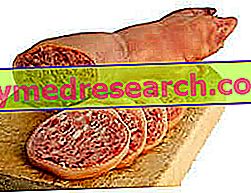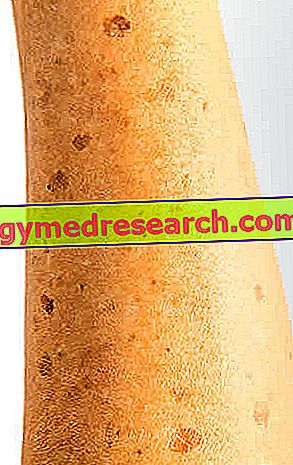What is Zampone?
Zampone is a gastronomic preparation based on minced meat, fat and rind mixed with other ingredients such as salt and spices (similar to cotechino).

More specifically, the zampone belongs to the set of preserved meats; it is a sausage to be eaten after cooking (long and sustained) since, in the absence of heat treatment, the zampone does not make use of sufficient digestibility.
Zampone and Zampetto
The zampone is NOT the paw; the latter consists of the fresh limb of the pig (trinomial nomenclature: Sus scrofa domesticus ) appropriately cleaned and cooked, while the zampone is a "typical salami" which involves a specific manufacturing process of pork meat.
The zampone is distinguished from salami, sausages, cotechino, nduja, salama da sugo, sanguinaccio etc. for the different bagging fabric; that is, while the minced meat of the other products is placed in animal (bovine) or synthetic (for example of cellulose) casings, or in other pockets constituted by hollow organs (for example the bladder), the meat of the zampone is bagged inside a pig's foot. The limb in question is carefully emptied of the muscles and bones and only preserves the outer rind, fingers and nails; the coating of the zampone, before the bagging, is therefore totally hollow.
Zampone "by definition" is a salami-sausage to be cooked, typical of Emilia, in particular in the province of Modena, which has obtained the recognition of Protected Geographical Indication (PGI). It seems that the first historical traces of the production of knuckles date back to the 1500s, in the area of Mirandola (common site at the northern limit of the province of Modena, on the border with the Lombardy area of Mantua and, to the east, close to the western countryside of Ferrara). It is no coincidence that, in addition to their respective hometowns, zampone is also widespread in the Ferrara and Mantua areas, but also in the Reggio and Parmesan areas, as well as towards the Cremona area.
At the sight, the zampone looks like a real front leg of a pig, the latter comprised by the knee-pad onwards. When raw it is full, trophic and pink; it has a ligature at the upper vertex, near the cut, and preserves the total integrity in the rest of the sausage. From cooked it acquires a darker and shinier color, and the consistency fluctuates from the solid / compact external to the vaguely gelatinous and friable inside (due to the collagen in the rind). The average weight of a knuckle is about 1 / 2kg, while the length is always less than 50cm.
Production
The production of the zampone occurs in a similar way to the cotechino, from which it is differentiated by the bagging wrapper. The zampone ground mixture is mainly based on: lean meat (shoulder, thigh and head; in total about 35%), fatty meat (especially throat and cheek; in total about 35%) and rind (in total approx. 30%). Then the salt, pepper and other spices such as: cloves, cinnamon, nutmeg, etc. are added to the batter. (some also use wine).
Once the preparation of the dough is finished, the bagging takes place inside the clean and well emptied leg; to conclude, it is necessary to tie / sew the vertex that prevents the escape of the cooking content. At this point the zampone can be used for "fresh" sale or for the "packaged" product.
Precooked Trotter
As regards the packaged product, it is necessary to subject it to pre-cooking; this process takes place by protecting the zampone in aluminum bags, steaming it for several hours (about 5) and allowing temperatures of ≥ 80 ° C to be reached at the heart of the product. Finally, the zampone is vacuum sealed, packaged, labeled and offered for sale. NB . the precooked knuckle can also be preserved at room temperature since, in addition to cooking and storage in vacuum, it is often added with antioxidants (ascorbic acid or vitamin C), preservatives (sodium nitrite) and flavor enhancers (monosodium glutamate); concentrations vary according to the brand and product quality.
Kitchen
The fresh zampone needs a very long cooking, to be done in cold water or in a pressure cooker; it has a gastronomic value definitely superior to that of the precooked knuckle which, on the other hand, makes use of a greater practicality to consumption (shorter cooking times).
Zampone should be served with a strong flavor, rich and basically cooked; mashed potatoes and stewed lentils are particularly suitable. The most suitable food-wine pairing with zampone is undoubtedly the one with red wines, full-bodied and endowed with a strong degreasing power, for example Lambrusco di Sorbara, Oltrepo 'Pavese of Pinot Nero or Aquileia Merlot.
Nutritional properties
Zampone is a fat and highly energetic food; it is not suitable for the hypocaloric diet against overweight and, in general, its consumption should be limited to the Christmas holiday period.
The caloric intake of the zampone is given mainly by lipids, which tend to be saturated, which in association with cholesterol (also present) make zampone a product to be avoided in the event of hypercholesterolemia.
Zampone proteins are remarkable and of high biological value.
From the saline point of view, the zampone brings bioavailable iron and high concentrations of sodium. The latter, if in excess in the diet, can represent a risk factor for the onset of hypertension or aggravate the pre-existing entity. Zampone is therefore not recommended for people who are familiar with hypertension, overt hypertension or high-risk cardio-vascular type.
From a vitamin point of view, zampone should be rich in water-soluble B vitamins; obviously, in the presence of considerable cooking times, it is reasonable to think that the thermolabile portion of these nutrients is lost or drastically reduced.
Nutritional values
Nutritional composition for 100g of Zampone, precooked packaged and Zampone, packaged precooked [boiled for 20 'inside the pack and drained from the liquid produced by cooking] - Reference values of the Food Composition Tables - INRAN
 | |||
| Zampone, pre-cooked packaged | Zampone, packaged precooked - annealed and drained | ||
| Edible part | 100.0% | 100.0% | |
| water | 45.5g | 50.0g | |
| Protein | 19.1g | 21.4g | |
| Prevailing amino acids | - | Glutamic acid, glycine, aspartic acid | |
| Limiting amino acid | - | - | |
| Lipids TOT | 31.6g | 25.9g | |
| Saturated fatty acids | - g | 8.48g | |
| Monounsaturated fatty acids | - g | 12.71g | |
| Polyunsaturated fatty acids | - g | 2.91g | |
| Cholesterol | - mg | 95.0mg | |
| TOT Carbohydrates | 0.0g | 0.0g | |
| Starch | 0.0g | 0.0g | |
| Soluble sugars | 0.0mg | 0.0mg | |
| Dietary fiber | 0.0g | 0.0g | |
| Soluble | 0.0g | 0.0g | |
| Insoluble | 0.0g | 0.0g | |
| Power | 361.0kcal | 319.0kcal | |
| Sodium | 762.0mg | 699.0mg | |
| Potassium | 104.0mg | 95.0mg | |
| Iron | 1.5mg | 1.4mg | |
| Football | 22.0mg | 20.0mg | |
| Phosphorus | 170.0mg | 96.0mg | |
| Thiamine | 0.26mg | 0.27mg | |
| Riboflavin | 0.21mg | 0.28mg | |
| Niacin | 3.00mg | - mg | |
| Vitamin A | tr | tr | |
| C vitamin | 0.0mg | 0.0mg | |
| Vitamin E | - mg | - mg | |



